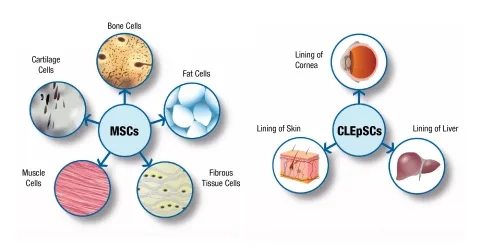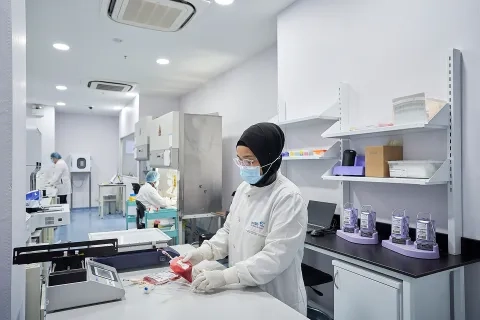Cord Blood Banking - What It Means for your Family's Future

Welcoming your newborn is a joyous occasion filled with many decisions. One important decision to consider is cord blood banking — the collection and preservation of lifesaving stem cells from your baby’s umbilical cord. This simple, painless procedure can offer significant health benefits for your child and family.
What's So Special About Cord Blood?
Packed with Stem Cells
Blood-forming stem cells, also called Haematopoietic Stem Cells (HSCs), can be found in your baby’s cord blood and can differentiate into various blood cells such as:

These lifesaving stem cells have the potential to treat more than 80 diseases1, including some common types of cancer like leukaemia, neuroblastoma, and lymphoma, as well as blood disorders such as thalassemia. They also have the ability to treat various immune and metabolic disorders, as well as solid tumours. Additionally, ongoing research into their potential applications for other diseases continually expands the therapeutic possibilities of cord blood stem cells.
A Family Safety Net
Storing your baby’s cord blood can benefit not only your baby but also her siblings and other family members. Biological siblings have a 40-60% chance of being a partial match2, giving parents a much-needed reassurance that a readily available source of stem cells is within reach. This also allows families to act quickly in times of need to ensure the best possible outcome for their family’s well-being.
Why Store Cord Blood?
A Future-Ready Medical Resource
Storing your baby’s cord blood ensures a ready source of stem cells for potential future treatments. Autologous transplants—where a person receives their own stem cells—lead to better outcomes and lower risks of complications like graft-versus-host disease3.
Future Possibilities
Research is actively exploring the use of cord blood stem cells in treating Autism Spectrum Disorder, Cerebral Palsy, Type 1 Diabetes, Alzheimer’s disease, spinal cord injury, and many other conditions1. Clinical trials have shown encouraging results, with many patients experiencing improved motor function, cognitive abilities, and overall quality of life following stem cell transplants.
As parents, it’s natural to be cautious about clinical trials, but they are carefully designed, highly regulated and led by medical experts to ensure safety at every stage. With strict ethical guidelines and regulations, every step taken is to prioritise patient safety while driving progress in regenerative medicine. Many trusted medical treatments today, from vaccines to cancer treatments, started as clinical trials that saved and changed many lives. For families facing conditions with no known cure, clinical trials offer hope and provide new therapeutic options.
A Once-In-A-Lifetime Chance

Can Only be Collected at Birth
Cord blood collection is a quick, safe and painless procedure that happens moments after delivery, with no risk to mother or baby. Once your baby has been safely delivered, the umbilical cord is cut, the remaining blood—rich with powerful stem cells—is gathered in a process that takes mere minutes and doesn’t interfere with childbirth. But here’s the catch: this is the only chance to collect these unique cells. It’s your one chance to preserve a potential lifeline for your child’s future health—a precious resource you can only obtain at birth.
A Small Step, Big Impact
This simple decision today could provide life-changing treatments for your family in the future. With the increasing number of clinical trials and research studies focusing on cord blood stem cell applications, storing your baby’s cord blood is a proactive step that opens up additional medical possibilities and options for the future.
Safeguard Your Child’s Health for a Lifetime
Guaranteed Match for your Baby
The cord blood you are saving for your baby now could be used as a medical resource in the future. Every year, 40–60% of patients in Singapore who need a stem cell transplant can’t find a good match in public cord blood banks or among bone marrow donors4. The odds of finding a match within the same racial group are only 1 in 20,0005.
Readily Available Medical Resource
In medical emergencies, time is critical. Stored stem cells provide a fast, reliable, and cost-effective solution, avoiding long donor searches that can be time-consuming and cost up to $75,000 in Singapore⁶. For urgent conditions like aggressive cancers or immune disorders, having a readily available unit ensures treatment can begin without delay, giving families peace of mind when it matters most.
Family Protection
Umbilical cord blood stem cells from a sibling offer a lifetime of protection for the family as the stored stem cells offer up to a 60% chance of matching amongst biological siblings2, serving as a form of biological insurance for the family.
Unlock The Potential of Cord Lining Banking with Cordlife’s CellOptimaTM Technology

Cordlife provides expecting parents with the option to collect, process and store stem cells from their baby’s umbilical cord lining, preserving a valuable resource for potential future medical use. Utilizing patented CellOptima™ technology, Cordlife is able to isolate and expand two vital stem cell types: Mesenchymal Stem Cells (MSCs) and Cord Lining Epithelial Stem Cells (CLEpSCs). They are the ‘muscle-forming’ & ‘skin-forming’ building blocks in the human body which have shown great potential in aiding the repair of injured tissues & organs. MSCs and CLEpSCs have vast potential therapeutic applications in regenerative medicine because their immune-modulating traits mean they don’t need an exact donor-patient match. Notably, Cordlife is the only cord blood bank in Singapore licensed to store CLEpSCs, providing families with unique access to this advanced therapeutic resource.
Comprehensive Protection with Diverse Stem Cells
By storing HSCs, MSCs and CLEpSCs, families secure a well-rounded biological resource that offers a broader spectrum of medical possibilities. These three stem cell types work together to support regenerative treatments, immune support and future medical advancements.

HSCs: Essential for treating blood-related disorders and cancers by replenishing blood cells and restoring immune function.
MSCs: Capable of differentiating into bone, cartilage and muscle cells, MSCs are being explored for their potential in repairing tissues and treating conditions like stroke, heart failure, and spinal cord injuries.
CLEpSCs: These cells can transform into skin, corneal and liver cells, offering promising potential for treating skin wounds, ocular surface disorders and liver diseases.
Designed with Quality and Long-Term Security in Mind
Cordlife’s dedication to excellence is evident in their continuous efforts to enhance service reliability and quality:
Enhanced Security Through Rigorous Checks
Their laboratory operates 365 days a year, adhering to strict protocols to safeguard your child’s cord blood and includes multiple daily checks and vigilant monitoring to ensure optimal storage conditions every day.
Fortified Failsafe Measures
Cordlife has strengthened failsafe measures to ensure uninterrupted protection. Systems are fortified with multiple layers of redundancy, ensuring your child’s cord blood remains secure even in the face of unexpected challenges.
Newly Enhanced Lab Monitoring System
Cordlife’s advanced lab monitoring system provides 24/7 real-time on-site and remote surveillance, proactive alerts, and built-in redundancies for uninterrupted protection. They’ve also implemented a three-tiered escalation protocol to ensure swift action when needed.
Backed by Experts for Quality
Cordlife maintains rigorous quality standards in all aspects of operations, guided by Medical and Technical Advisory Board, which includes leading industry experts.
More Experienced Lab & Technical Personnel
Cordlife has brought on board seasoned professionals who bring a wealth of experience to every aspect of their operations, from routine checks and cord blood processing to critical interventions.
Extensive Training for Cordlife’s Lab Team
Cordlife has enhanced its laboratory team’s expertise through comprehensive training programmes, ensuring they possess the knowledge and skills necessary to uphold their stringent protocols.
Advanced Paediatric Diagnostic Services

Understanding the importance of early detection and intervention, Cordlife offers state-of-the-art diagnostic services for children as young as six months old.
Paediatric Vision Screening (Eyescreen™):
A non-invasive test designed to detect common vision problems in young children, such as amblyopia and strabismus, facilitating timely treatment.
Paediatric Hearing Screening (Earscreen™):
Aims to identify hearing impairments in infants and young children early on, ensuring that necessary support and interventions are provided promptly.
Talent Screening:
A unique service that assesses a child’s innate talents and potential, offering parents insights to nurture their child’s development effectively.
Final Thoughts: A Simple Choice for a Healthier Future
Cord blood banking goes beyond a simple medical choice—it’s a lasting investment in your family’s well-being. By choosing to store your baby’s cord blood, you’re securing a unique resource that could one day offer healing and hope, gifting your loved ones a head start for a healthier future.
This article was adapted from Mummys Market Shopping Magazine, Issue Apr 2025.
1 Diseases treated page. Parent’s Guide to Cord Blood Foundation website. https://parentsguidecordblood.org/en/diseases. Accessed February 26, 2025.
2 Jawdat DM, Al Saleh S, Sutton P, et al. Chances of finding an HLA-matched sibling: The Saudi experience. Biol Blood Marrow Transplant. 2009;15(10):1342-1344.
3 Champlin R. Selection of autologous or allogeneic transplantation. In: Kufe DW, Pollock RE, Weichselbaum RR eds.. Holland-Frei Cancer Medicine. 6th ed. Hamilton (ON): BC Decker; 2003. https://www.ncbi.nlm.nih.gov/books/NBK12844/. Accessed March 3, 2025.
4 Cord blood donation page. Singapore General Hospital website. https://www.sgh.com.sg/patient-care/specialties-services/cord-blood-donation. Updated October 18, 2018. Accessed March 3, 2025.
5 Yuen S. Wanted: More bone marrow donors from minority races. The Straits Times. September 18, 2016:13.
6 Cord blood banking in Singapore – how much does it cost & is it worth the money? page. Yahoo Finance Website. https://sg.finance.yahoo.com/news/cord-blood-banking-singapore-much-160000981.html. Published August 31, 2018. Accessed February 26, 2025.
Recent Blog Posts
- 01 Aug 2025
- 02 Jun 2025
- 28 Mar 2025
- 10 Nov 2023
- 19 Oct 2022

